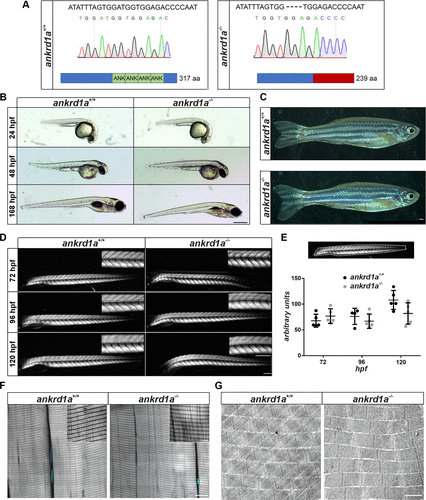Fig. 7 Characterization of ankrd1a mutant zebrafish. A: DNA sequences, electropherogram of ankrd1a+/+ and ankrd1a−/− alleles, and schematic representation of wild-type (wt) and mutant Ankrd1a protein structure. Hyphens indicate deleted bases, and ANK is ankyrin repeat. B: lateral view of wt (ankrd1a+/+) and ankrd1a mutant (ankrd1a−/−) embryos and larvae imaged at designated time points. Scale bar, 0.5 mm. C: appearance of adult ankrd1a+/+ and ankrd1a−/− zebrafish. Scale bar, 1 mm. D: birefringence analysis of ankrd1a−/− and ankrd1a+/+ somites at designated timepoints. Representative images are shown, n = 10 larvae per each timepoint and genotype. Lateral views, anterior to the left. Scale bar, 200 μm. E: birefringence quantification was performed within the outlined area and expressed as pixel intensities (gray values). No significant difference in muscle integrity between ankrd1a−/− and ankrd1a+/+ was observed (P > 0.05). F: Phalloidin staining of adult ankrd1a−/− and ankrd1a+/+ zebrafish skeletal muscle (n = 3) showed a characteristic striated pattern of actin filaments. Nuclei were stained with DAPI (cyan). Scale bars, 10 µm and 25 µm for insets. G: Transmission electron microscopy (TEM) analysis reveals regular sarcomere organization in ankrd1a−/− zebrafish (n = 4), with no pathological signs. Scale bar, 1 µm. F and G are representative images of one analyzed zebrafish.
Image
Figure Caption
Acknowledgments
This image is the copyrighted work of the attributed author or publisher, and
ZFIN has permission only to display this image to its users.
Additional permissions should be obtained from the applicable author or publisher of the image.
Full text @ Am. J. Physiol. Cell Physiol.

